When Gen. Carrol H. Chandler took command of Pacific Air Forces last November, he retained as his own the top priorities of his predecessor, Gen. Paul V. Hester. He did this for two fundamental reasons. First, Chandler thought PACAF was already headed in the right direction. Second, he said, “There was no reason to create more turmoil.” He explained, “This was an effort to ‘freeze the stick’ around the priorities that people had been working on for almost three years.”
The turmoil to which Chandler refers is the cumulative effect of USAF’s personnel drawdown, the demands of the Global War on Terror, deployments to Iraq and Afghanistan, reduction of US forces in South Korea, the buildup of air and naval forces in Guam, the movement of 13th Air Force from Guam to Hawaii, and revision of the mission of 7th Air Force in Korea.
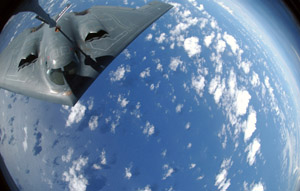 |
A KC-135 refuels a B-2 over the Pacific Ocean. |
The turbulence has taken a toll. For example, the PACAF commander worries about the retention of midlevel noncommissioned officers in his command. In addition to the demands of their regular jobs, the airmen face multiple deployments to Iraq and Afghanistan, and many are of an age when they want to start families. “They’re tired,” he says.
Moreover, the dangers have remained large and constant. Potential threats PACAF faces today are known to any attentive newspaper reader: a rising China, resurgent Russia, and recalcitrant North Korea. They are among the reasons Chandler says: “While the Pacific region is not at war, neither is it at peace.”
Faced with this situation, Chandler has come to believe that enlightened leadership means recruiting and training good people, giving them the tools to do their jobs, and then “just getting out of the way and letting them do it.” He adds in the next breath: “That doesn’t mean we throw the regulations out the window. We’re always here to give them guidance.”
After taking command, Chandler visited all nine major USAF bases in Hawaii, Alaska, South Korea, Japan, and Guam as well as the capitals Seoul, Tokyo, and Singapore. He concludes that PACAF actually has a “luxury” because of the demands on its airmen.
“When you come to us, you will be able to start doing the job you were trained for. You grow up in a hurry … because we give you as much responsibility as you can take as quickly as you can.”
Among the critical duties of senior officers in the Pacific region is the attempt to build serious engagement with China as the communist regime dedicates earnings from its surging economy to modernize its military forces.
“How Do We Deal With China?”
Adm. Timothy J. Keating, commander of US Pacific Command, has been to China twice and will most likely go again sometime within the next year. Senior Chinese officers reciprocate in coming to the US, usually beginning with a visit to PACOM on the way to Washington.
Chandler has not been to China but is prepared to accept an invitation if offered. He recognizes that “the Chinese are rapidly moving forward with significant aerospace developments based on improvements to existing foreign technologies.” Much of that foreign technology comes from Russian weapons. Chandler’s Chinese counterpart was scheduled to visit him in the spring but canceled after the devastating earthquake in southwestern China.
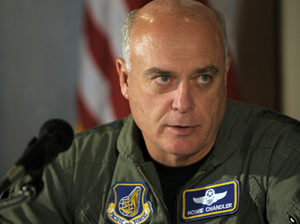 |
Gen. Carrol Chandler, PACAF commander. |
“The question is,” Chandler asks, “how do we deal with China?” He believes the US can avoid a cold war of the type that for more than four decades characterized US relations with the Soviet Union.
“I think we have an opportunity so long as we deal with the Chinese from a position of strength,” he says, “so that we do not miscalculate and we do not misunderstand each other.” He says the US must ensure “the Chinese do not think that somehow they could exclude us from the [Asian] side of the Pacific.”
Where many US military leaders see terror as the top threat, Chandler tends to focus on nuclear proliferation, particularly as it regards the “reclusive and unpredictable” regime in North Korea. PACAF officers suggest that North Korea’s nuclear capability not only affects the Korean peninsula’s military balance but broader regional stability.
Transfer of nuclear technology or material to potential enemies, national or transnational, threatens the US and its allies—and US military forces. Moves to acquire nuclear weapons would be highly destabilizing.
China, for example, has made clear its firm stance that any action by Taiwan to acquire nuclear arms would justify Chinese military action, which might require a US response under the Taiwan Relations Act.
Confronted with those threats, Chandler’s priorities in PACAF’s sprawling area of responsibility are properly positioning forces, providing combat capability to Pacific Command, offering humanitarian assistance when needed, and engagement both with friends and potential adversaries, notably China.
Underpinning all is the task of developing and sustaining a force of top-notch airmen. Chandler says his task is to balance requirements for the long haul with needs of the combatant commander, who, he noted, tends to take the position of, “What have you done for me lately?”
PACAF must integrate three squadrons of F-22 Raptors into its operations to provide immediate response in a crisis. One F-22 squadron is to be based at Hickam AFB, Hawaii, and two at Elmendorf AFB, Alaska. All are expected to rotate through Guam on deployments.
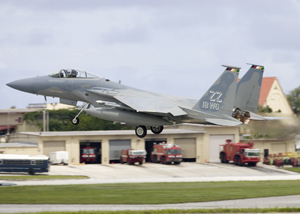 |
An F-15 takes off from Andersen AFB, Guam. |
Later, USAF may station F-35 Lightning squadrons at Eielson AFB, Alaska, and at Kadena Air Base on the Japanese island of Okinawa.
A persistent bomber presence of B-52H, B-1B, and B-2 bombers rotating to Guam will continue as the US presses ahead with upgrades to Andersen Air Force Base and that island’s infrastructure.
KC-135 tankers based in Hawaii, Alaska, and Japan (and also rotating through Guam) form a perpetual air bridge here to help overcome the region’s vast distances.
A pressing need, Chandler says, is to strengthen PACAF’s intelligence-surveillance-reconnaissance capabilities. “Recent ballistic missile and underground nuclear testing by North Korea, successful anti-satellite operations by China, and the increased number of Russian long-range bomber missions in the Arctic have further emphasized the need to remain vigilant,” he says.
The expected arrival, in 2009, of the first of three or four long-range, high-altitude Global Hawk unmanned aerial vehicles will do much to improve PACAF’s ISR capabilities. Global Hawk is packed with sensors designed to detect everything from mobile nuclear launchers to pirates at sea.
Intelligence analysis is equally important, and analysts must be culturally astute to provide commanders with the context needed to make proper decisions. PACAF has brought in a foreign policy advisor, Brian Woo, from the State Department for that purpose. Chandler says the command must “continue the professional development of regional affairs specialists and support requirements for more human intelligence capability.”
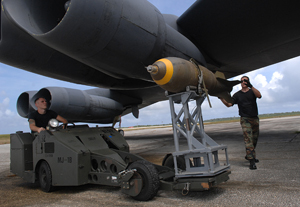 |
Maintainers prep a B-52 bomber on the flight line at Andersen AFB, Guam. USAF’s heavy bombers are continuously deployed to the island. |
Vast New Training Space
To keep PACAF’s combat readiness high, the command relies on training exercises such as Northern Edge in Alaska (primarily for USAF and Navy aircrews), Red Flag Alaska for USAF and allied crews, and the expertise in an expanding array of air operations centers.
The large force-package exercises frequently make use of Alaska’s training space. At Red Flag Alaska in April, US pilots were joined by those from Australia, Britain, and Canada. A month later, at Northern Edge, 120 aircraft from PACAF bases, plus those from the Naval Strike and Air Warfare Center in Nevada, trained over land and sea. At Red Flag Alaska in June, 16 Tornados from the German Air Force and four Stinger missile teams from Japan’s Air Self-Defense Force took part.
Chandler wants to bring Red Flag Alaska up to the level of the Red Flag at Nellis AFB, Nev. He wants the two to complement each other, not compete with each other. “We still have to work on some instrumentation in Alaska,” he says. While sparsely populated Alaska has much open airspace away from residential areas, USAF fliers must be aware of “bush pilots.”
“Civil aviation is a big part of what goes on in the state,” Chandler says. “If we’re going to use that much airspace, then we need to understand how we’re going to interact with light, commercial aviation.”
PACAF’s key fighting element is 13th Air Force. Its 613th Air and Space Operations Center is tasked to plan, command, and control an air campaign. Housed next door to PACAF headquarters, the darkened AOC cavern—with more than 200 flickering computer screens—has USAF, Navy, Army, and Marine Corps operators, plus representatives of other agencies running a full range of modern air operations, all under the watchful eye of a campaign commander in a central battle cab.
The 13th Air Force AOC will have close ties with the new US-Japanese bilateral air operations center being built at Yokota AB, Japan, and will also work with the Australian AOC in Canberra. The region’s best known AOC is in South Korea “where, for over 30 years, US and [South] Korean airmen have developed the model for conducting combined air and space operations,” Chandler said. Another AOC, situated in Alaska, is used to synchronize air operations for NORAD.
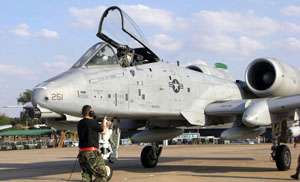 |
An airman marshals an A-10 at Korat RTAB, Thailand. Members of the 25th Fighter Squadron, Osan AB, South Korea, were there to participate in an exercise. |
Meanwhile, the communications and navigation satellites serving PACAF need to be replaced. “Many of these satellites have outlived their designed endurance,” Chandler says.
The first Wideband Global SATCOM satellite went operational in April, providing better communication from Pacific Command to the West Coast. “Over the next 10 years,” Chandler says, “the Air Force must recapitalize all of these systems to maintain the advantage our space capability provides our nation.”
PACAF’s top priorities, obviously enough, are to deter war if possible or defeat an enemy if necessary. Right behind those, however, is the goal of winning friends and influencing potential adversaries.
The concept goes by various names—theater security cooperation, engagement, humanitarian assistance-disaster relief, regional stability. Whatever the name, however, it consumes lots of PACAF’s attention, time, and resources. Chandler says: “We must maintain high-end capabilities while conducting low-end operations.” Success in these operations can depend on the cooperation of other nations.
After a May cyclone devastated Myanmar, PACAF positioned C-130s loaded with fresh water and other supplies at U Tapao RTAB, Thailand, to be ready to supply help. More than 100 C-130 and Marine KC-130 flights eventually went into Burma, but some sat on the runway there and eventually left when the junta refused to allow the US to deliver relief supplies.
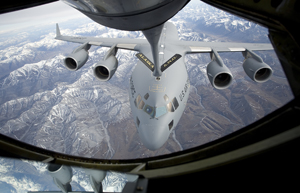 |
A C-17 takes on fuel from a KC-135 tanker over the mountains of Alaska during a Red Flag Alaska exercise. |
The Humanitarian Angle
This February, by contrast, C-17s loaded with blankets and shelters took off for China within 18 hours of a request for help with the aftermath of a severe snowstorm. In May, C-17s flew relief supplies and tents into China after an earthquake took tens of thousands of lives and left millions homeless.
PACAF a few months ago also mounted a medical mission, called Pacific Angel, to remote areas of Cambodia and Thailand. “This humanitarian assistance,” Chandler says, “resonates with just about everybody.”
Pacific Air Forces each year takes part in roughly 30 international exercises, including big ones such as Cope India, with India’s Air Force, and Cobra Gold, in Thailand. Other exercises are held with aviators from Australia, Japan, South Korea, Singapore, Malaysia, and Indonesia. Chandler says scenarios are set 10 to 20 years in the future with topics covering the full spectrum of conflict.
Chandler seeks to expand intelligence sharing among allies and partners. Specifically, he says, opening an “information-sharing aperture” was the purpose of the Global Hawk Capabilities Forum held in April at Hickam and a companion trip to Beale Air Force Base, the California home of the RQ-4. At these events, representatives of Japan, Australia, South Korea, Philippines, Singapore, Indonesia, Malaysia, Thailand, Brunei, Sri Lanka, and India took briefings on Global Hawk’s capabilities as the US encouraged cooperation in combating terror and piracy and supporting humanitarian assistance.
Chandler observed, “Some have suggested that the United States may be neglecting its security in the Asia-Pacific because it has been too focused on Iraq, Afghanistan, and conflicts in other regions.” Some, he went on, are concerned that “US military strategy and resource decisions are overly devoted to current threats,” to the detriment of the skills and equipment needed against future adversaries.
“America,” Chandler contends, “can and must be able to do both.”
|
Pacific Air Forces at a Glance Headquarters Hickam AFB, HawaiiNumbered Air Forces 5th Air Force, Yokota AB, Japan7th Air Force, Osan AB, South Korea 11th Air Force, Elmendorf AFB, Alaska 13th Air Force, Hickam AFB, Hawaii
Principal Bases
Eielson AFB, Alaska Elmendorf AFB, Alaska Hickam AFB, Hawaii Kadena AB, Japan Kunsan AB, South Korea Misawa AB, Japan Osan AB, South Korea Yokota AB, Japan
Major Units
8th Fighter Wing, Kunsan AB, South Korea 15th Airlift Wing, Hickam AFB, Hawaii 18th Wing, Kadena AB, Japan 35th Fighter Wing, Misawa AB, Japan 36th Wing, Andersen AFB, Guam 51st Fighter Wing, Osan AB, South Korea 354th Fighter Wing, Eielson AFB, Alaska 374th Airlift Wing, Yokota AB, Japan |
Richard Halloran, formerly a New York Times foreign correspondent in Asia and military correspondent in Washington, D.C., is a freelance writer based in Honolulu. His most recent article for Air Force Magazine, “Pacific Choke Point,” appeared in the July issue.